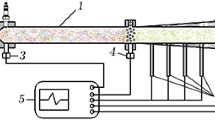Abstract
The possibility of increasing the velocity of solid particles accelerated by an explosion of a long tubular charge of a high explosive (HE) in vacuum is analyzed. The experimental results obtained indicate that the acceleration velocity cannot be considerably increased. The probable causes are erosion of the material from the inner surface of the HE tube and a significant decrease in the mass flow velocity when the length of the HE tube exceeds the optimum length.
Similar content being viewed by others
References
D. M. Woodhead, “Velocity of detonation of a tubular charge of explosive,”Nature,160, No. 4071, 644 (1947).
D. M. Woodhead, and H. Titman, “Detonation phenomena in a tubular charge of explosive,”Explosivstoffe,13, No. 5, 113–123 (1965).
V. M. Titov, Yu. I. Fadeenko, and N. S. Titova, “Acceleration of solid particles by a cumulative explosion,”Dokl. Akad. Nauk SSSR,180, No. 5, 1051–1053 (1968).
A. S. Zagumennov, N. S. Titova, Yu. I. Fadeenko, et al., “Detonation of long cavitated charges,”Prikl. Mat. Tekh. Fiz., No. 2, 79–83 (1969).
V. M. Titov and G. A. Shvetsov, “Laboratory methods of high-velocity acceleration of solids by explosion,”Fiz. Goreniya Vzryva,6, No. 3, 401–405 (1970).
V. V. Sil’vestrov and V. P. Urushkin, “Method of determining the density of high-velocity gas jets”, in:Dynamics of Continuous Media (collected scientific papers) [in Russian], Novosibirsk, 7 (1971), pp. 25–129.
G. V. Pryakhin, V. M. Titov, and G. A. Shvetsov, “Investigation of high-velocity gas flows by an electromagnetic method,”Prikl. Mekh. Tekh. Fiz., No. 3, 137–140 (1971).
Yu. I. Fadeenko, V. F. Lobanov, V. V. Sil’vestrov, and V. M. Titov, “High speed gas flows in explosions of cavitated explosives,”Acta Astronautica,1, 1171–1179 (1974).
L. A. Merzhievskii, and V. M. Titov, “High-velocity impact (review),”Fiz. Goreniya Vzryva,23, No. 5, 92–109 (1987).
V. V. Bashurov, G. V. Bebenin, G. V. Belov, et al. “Experimental modeling and numerical simulation of high- and hypervelocity space debris impact to spacecraft shield protection,”Int. J. Impact Engng.,20, Nos. 1–5, 69–78 (1997).
G. V. Belov, V. K. Golubev, and N. A. Yutkina, “Damage of a steel plate from hypervelocity impact,”Fiz. Goreniya Vzryva,33, No. 1, 119–121 (1997).
N. M. Kuznetsov,Thermodynamic Functions and Shock Adiabat in Air at High Pressures [in Russian], Mashinostroenie, Moscow (1965).
A. I. Byvshikh, “Numerical study of thermal processes in gas cumulation,” Abstract of Candidate’s Dissertation in Phys.-Math. Sci., Krasnoyarsk (1997).
Author information
Authors and Affiliations
Additional information
Translated fromFizika Goreniya i Vzryva, Vol. 35, No. 4, pp. 102–105, July–August 1999.
Rights and permissions
About this article
Cite this article
Lazorskii, P.A., Plastinin, A.V., Sil’vestrov, V.V. et al. Acceleration of solid particles during cumulation of detonation products in vacuum. Combust Explos Shock Waves 35, 443–446 (1999). https://doi.org/10.1007/BF02674481
Received:
Issue Date:
DOI: https://doi.org/10.1007/BF02674481



